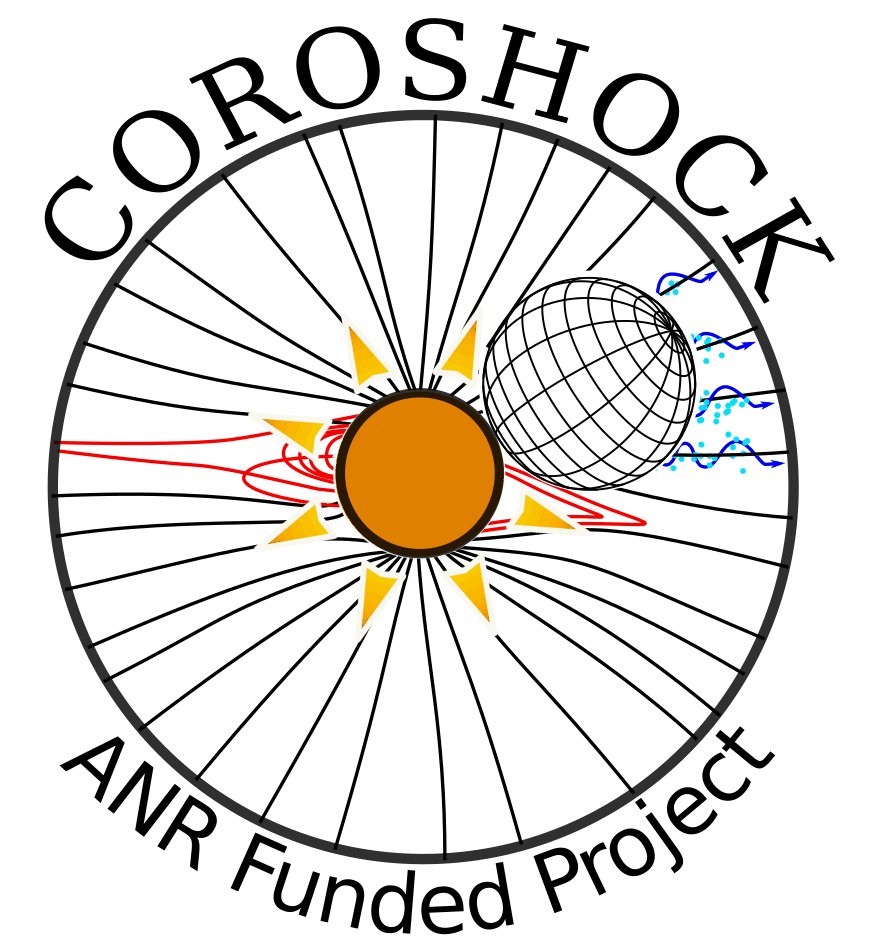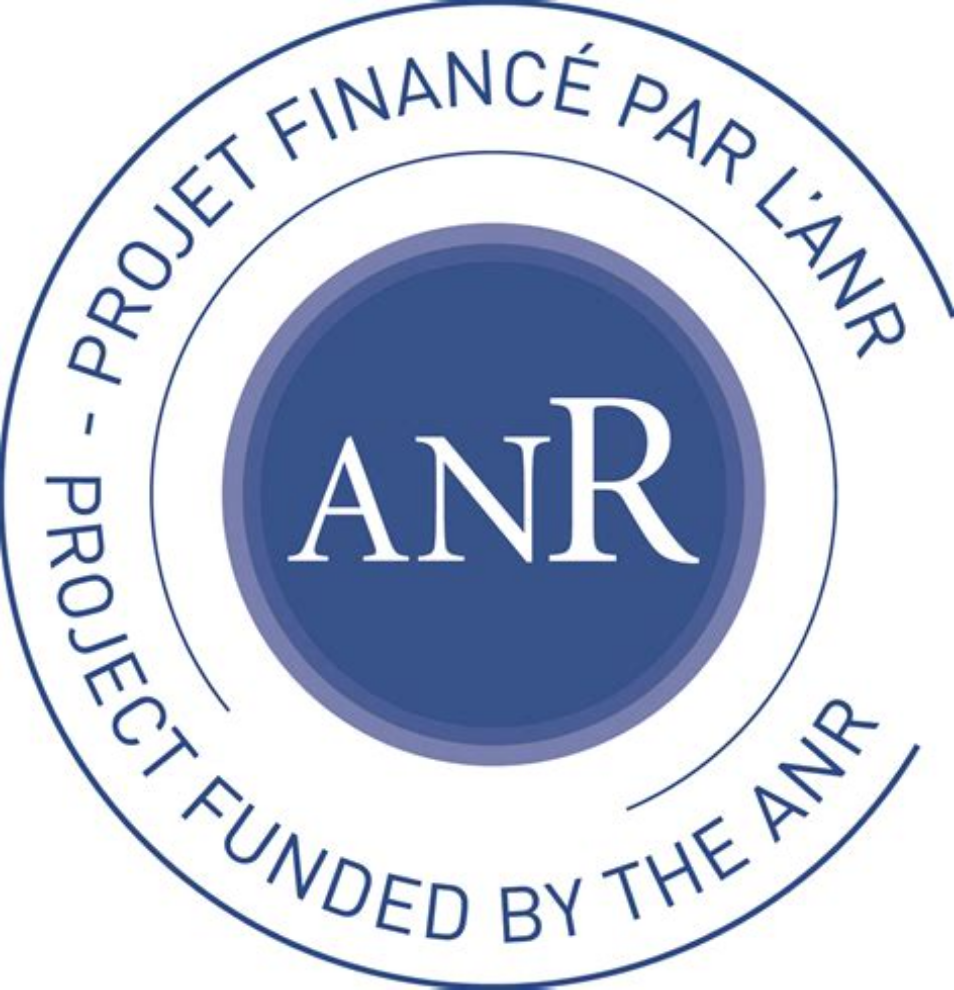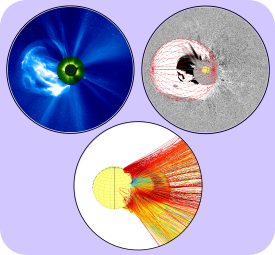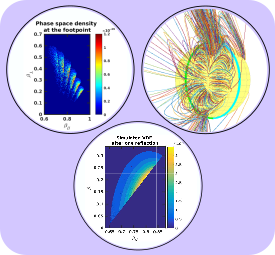

The COROSHOCK is an ANR funded project that addresses one of the remaining unsolved questions in solar physics: how are solar particles accelerated to high energies? Combining advanced coronal shock models with models that account for the physical processes known to operate in the corona and in the interplanetary medium during the acceleration and transport of particles we aim to answer the scientific hypothesis that coronal shocks act as the particle accelerators of the high-energy particles that produce the solar high-energy γ-ray events and the energetic particles measured near Earth.
To test the shock hypothesis as the prime particle accelerator we adapt existing advanced numerical models and exploit remote-sensing and in-situ data in an integrated manner. At the end of the COROSHOCK project we ultimate aim to have fully elucidated the role of coronal shocks as strong accelerators of the energetic particles that form the SEPs measured in-situ near 1AU and the high-energy electromagnetic radiations remotely sensed near the Sun.
Therefore, the fundamental questions to be addressed and finally answered are:
QUESTION 1
How well the 3-D evolution of shock waves can explain the properties of SEPs?
QUESTION 2
Is the variability and long-duration of >100 MeV γ-ray events controlled by the evolution of shock waves?
QUESTION 3
Can the particle acceleration/transport and the evolution of coronal shocks explain simultaneously the properties of SEPs and long-duration of >100 MeV γ-ray events?
The COROSHOCK project is a 4-year project (2017-2021) selected and funded by the French National Research Agency (ANR JCJC call 2016). Download our Final Report
Shock Wave Dynamics
To test the shock hypothesis as the prime particle accelerator in the heliosphere, it is essential the further development and the application of novel methods to determine the shock wave dynamics during solar eruptive events. We exploit coronal imagery in different vantage points and wavelengths to locate and map the time varying 3-D expansion of pressure waves and derive their magneto-plasma properties including: the velocity, Mach numbers, compression ratios and geometry in 3-D. Our methods, _that constitute the current state-of-the-art_, reside in forward shock modeling techniques using nearly simultaneous multi-viewpoint white light and EUV observations of pressure/shock waves combined with background coronal and solar wind MHD models to deduce the critical shock parameters in 3-D.

The application of the developed tools and methods during COROSHOCK project allow us to perform:
- Detailed 3-D reconstructions and modeling of coronal shock waves.
- Detailed coupling of the shock wave modelling with magnetic connectivity to evaluate the shock impact on specific regions of the inner heliosphere.
- Detailed analysis of the 3D shock wave properties and connection to SEP and γ-ray events properties.
- [Under-development] The construction of catalog of 3-D reconstructed and modeled shock waves for a plethora of eruptive events.
We account for the physical processes known to operate in the corona and in the interplanetary medium during the acceleration and transport of particles. The production of high-energy particles at the shock will be parameterized using the magneto-plasma shock parameters that are deduced from the 3-D reconstructions and modeling. The result of this parameterization will produce a time varying spectrum of particles at the shock. In addition, we will account for particle transport mechanisms in the interplanetary medium by developing a 3-D particle transport model based on the solution of stochastic differential equations to model the random walk of energetic particles during their propagation to 1AU. This approach is computationally tractable and much simpler to implement numerically than the solution of the full Parker transport equation using finite-difference schemes.

From the application of the acceleration and transport models to the modeled shock waves we will:
- Parameterise the particle energisation and modell particle propagation from the shock to the solar surface to explain the properties of the long-duration >100 MeV γ-ray events.
- Be able to study the longitudinal variability of SEPs through the coupled shock wave and particle transport modeling.
- Exploit the possibility to convert the flux of energetic particles into electromagnetic radiation to produce synthetic γ-ray, hard X-ray, and radio fluxes during highly energetic eruptive events.
Particule Acceleration & Transport
Publications & Presentations
Here you will find a selection of recent publications and presentations that have been elaborated during the COROSHOCK project:
Publications
- Papaioannou, A., Kouloumvakos, A., Mishev, A., et al., 2022, The first ground-level enhancement of solar cycle 25 on 28 October 2021, Astronomy and Astrophysics, 660, L5.
- Kouloumvakos, A., Kwon, R.~Y., Rodriguez-Garcia, L., et al., 2022, The first widespread solar energetic particle event of solar cycle 25 on 2020 November 29. Shock wave properties and the wide distribution of solar energetic particles, Astronomy and Astrophysics, 660, A84.
- Dresing, N., Kouloumvakos, A., Vainio, R., et al., 2022, On the Role of Coronal Shocks for Accelerating Solar Energetic Electrons, Astrophysical Journal Letters, 925, L21,
- Kollhoff, A., Kouloumvakos, A., Lario, D., et al., 2021, The first widespread solar energetic particle event observed by Solar Orbiter on 2020 November 29, Astronomy and Astrophysics, 656, A20.
- Jebaraj, I.C., Kouloumvakos, A., Magdalenic, J., et al., 2021, Generation of interplanetary type II radio emission, Astronomy and Astrophysics, 654, A64.
- Kouloumvakos, A., Rouillard, A.P., Warmuth, A., et al., 2021, Coronal Conditions for the Occurrence of Type II Radio Bursts, Astrophysical Journal, 913, 99.
- Wu, Y., Rouillard, A.~P., Kouloumvakos, A., et al., 2021, On the Origin of Hard X-Ray Emissions from the Behind-the-limb Flare on 2014 September 1Astrophysical Journal, 909, 163.
- Rouillard, A.~P., Pinto, R.~F., Vourlidas, A., et al., 2020, Models and data analysis tools for the Solar Orbiter missionAstronomy and Astrophysics, 642, A2.
- Kouloumvakos, A., Vourlidas, A., Rouillard, A.P., et al., 2020, The Solar Origin of Particle Events Measured by Parker Solar ProbeAstrophysical Journal, 899, 107.
- Kouloumvakos, A., Rouillard, A.P., Share, G.H., et al., Evidence for a Coronal Shock Wave Origin for Relativistic Protons Producing Solar Gamma-Rays and Observed by Neutron Monitors at Earth, The Astrophysical Journal, Volume 893, Issue 1, id.76, 14 pp. (2020)
- Griton, L., Pinto, R.~F., Poirier, N., et al., Coronal Bright Points as Possible Sources of Density Variations in the Solar Corona, The Astrophysical Journal, Volume 893, Issue 1, id.64, 14 pp.
- Rouillard, A.P., Poirier, N., Lavarra, M., et al., 2020, Modeling the Early Evolution of a Slow Coronal Mass Ejection Imaged by the Parker Solar Probe, Astrophysical Journal Supplement Series, 246, 72.
- Korreck, K.E., Szabo, A., Nieves Chinchilla, T., et al., 2020, Source and Propagation of a Streamer Blowout Coronal Mass Ejection Observed by the Parker Solar Probe, Astrophysical Journal Supplement Series, 246, 69. doi:10.3847/1538-4365/ab6ff9
- Poirier, N., Kouloumvakos, A., Rouillard, A.P., et al., 2020, Detailed Imaging of Coronal Rays with the Parker Solar Probe, Astrophysical Journal Supplement Series, 246, 60.
- Rouillard, A.P., Kouloumvakos, A., Vourlidas, A., et al., 2020, Relating Streamer Flows to Density and Magnetic Structures at the Parker Solar Probe, Astrophysical Journal Supplement Series, 246, 37.
- Giacalone, J., Mitchell, D.~G., Allen, R.~C., et al.,, 2020, Solar Energetic Particles Produced by a Slow Coronal Mass Ejection at ∼0.25 au, Astrophysical Journal Supplement Series, 246, 29.
- Hess, P., Rouillard, A.~P., Kouloumvakos, A., et al., 2020, WISPR Imaging of a Pristine CME, Astrophysical Journal Supplement Series, 246, 25.
- Kouloumvakos, A., Rouillard, A.~P., Wu, Y., et al., 2019, Connecting the Properties of Coronal Shock Waves with Those of Solar Energetic Particles, Astrophysical Journal Supplement Series, 876, 80.
- Afanasiev, A., Vainio, R., Rouillard, A.P., 2018, Modelling of proton acceleration in application to a ground level enhancement, Astronomy and Astrophysics, 614, A4.
- Howard, R.~A., Vourlidas, A., Bothmer, V., et al., 2019, Near-Sun observations of an F-corona decrease and K-corona fine structure, Nature, 576, 232.
- McComas, D.~J., Christian, E.R., Cohen, C.M.S., et al., 2019, Probing the energetic particle environment near the Sun, Nature, 576, 223.
- Zucca, P., Morosan, D.E., Rouillard, A.P., Fallows, R., Gallagher, P.T., Magdalenic, J., el al., 2018, Shock location and CME 3D reconstruction of a solar type II radio burst with LOFAR, Astronomy and Astrophysics, 615, A89.
Presentations
- Rouillard, Alexis; Kouloumvakos, A.; Kwon, R. -K. .; et al (SHINE 2018) Probing the Properties and Effects of Coronal Shocks Using Modeling, Simulations and Observations
- Kouloumvakos, Athanasios; Rouillard, A. P.; Vainio, R.; et al. (SHINE 2018) Connecting Shock Waves Properties in the Solar Corona with the Characteristics of Solar Energetic Particle Events
- Afanasiev, Alexandr; Vainio, Rami; Rouillard, Alexis; et al.; (EGU 2018) Modeling of proton acceleration in a shock in application to a ground level enhancement
Team Members
You're interested by the people who work on this wonderful project ? Want to know their names, their roles, and stalked them a little on the net ? Here they are. Treat them with love and honor, they deserved it.
IRAP Staff:
- PI: Alexis Rouillard
- Postdoc: Athanasios Kouloumvakos
- Postdoc: Yihong (Shirley) Wu
- Web developper: Matthieu Alexandre
- Illya Plotnikov
- Benoit Lavraud
External Collaborators:
- Angelos Vourlidas (JHAPL)
- Ryun Young Kwon (JHAPL)
- Alexander Warmuth (AIP)
- Alexandr Afanasiev (UTU)
- Gottfried Mann (AIP)
- Nicole Vilmer (OPM LESIA)
- Rami Vainio (UTU)